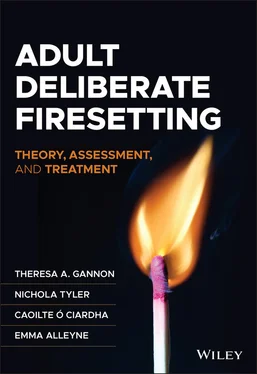Theresa A. Gannon - Adult Deliberate Firesetting
Здесь есть возможность читать онлайн «Theresa A. Gannon - Adult Deliberate Firesetting» — ознакомительный отрывок электронной книги совершенно бесплатно, а после прочтения отрывка купить полную версию. В некоторых случаях можно слушать аудио, скачать через торрент в формате fb2 и присутствует краткое содержание. Жанр: unrecognised, на английском языке. Описание произведения, (предисловие) а так же отзывы посетителей доступны на портале библиотеки ЛибКат.
- Название:Adult Deliberate Firesetting
- Автор:
- Жанр:
- Год:неизвестен
- ISBN:нет данных
- Рейтинг книги:5 / 5. Голосов: 1
-
Избранное:Добавить в избранное
- Отзывы:
-
Ваша оценка:
- 100
- 1
- 2
- 3
- 4
- 5
Adult Deliberate Firesetting: краткое содержание, описание и аннотация
Предлагаем к чтению аннотацию, описание, краткое содержание или предисловие (зависит от того, что написал сам автор книги «Adult Deliberate Firesetting»). Если вы не нашли необходимую информацию о книге — напишите в комментариях, мы постараемся отыскать её.
Explore the theoretical foundations of—and discover effective treatment options for—adults who deliberately set fires Adult Deliberate Firesetting: Theory, Assessment, and Treatment,
Adult Deliberate Firesetting: Theory, Assessment, and Treatment
Adult Deliberate Firesetting — читать онлайн ознакомительный отрывок
Ниже представлен текст книги, разбитый по страницам. Система сохранения места последней прочитанной страницы, позволяет с удобством читать онлайн бесплатно книгу «Adult Deliberate Firesetting», без необходимости каждый раз заново искать на чём Вы остановились. Поставьте закладку, и сможете в любой момент перейти на страницу, на которой закончили чтение.
Интервал:
Закладка:
Substance dependence.Some of the early conclusions of an association between substance dependence and adult firesetting (see, e.g., Gannon & Pina, 2010) were based on a literature limited by small sample sizes or lack of comparison groups (Grant & Kim, 2007; Lindberg et al., 2005; Ritchie & Huff, 1999). A number of more recent robust studies appear to support these initial conclusions (Alleyne et al., 2016; Blanco et al., 2010; Ducat et al., 2013b; Hoertel et al., 2011; Ó Ciardha et al., 2015a; Sambrooks et al., 2021; Vaughn et al., 2010). Sambrooks et al. (2021) reported meta-analytic findings suggesting that two thirds of individuals with a history of firesetting in their samples had diagnoses for substance-related issues. Nationally representative US data suggested that drug and alcohol use disorders were characteristic of men and women with a lifetime history of firesetting compared with those without (Blanco et al., 2010; Hoertel et al., 2011; Vaughn et al., 2010). Comparing a large sample of individuals convicted of arson offences with offending and community individuals, Ducat et al. (2013b) found that frequency of substance misuse diagnoses were higher for people who had set fires than either of the two other groups. Breaking down the same firesetting sample by gender, Ducat et al. (2017) reported that women who had set fires were more likely than men to have a psychiatric diagnosis of substance misuse. Two related studies looking at the psychopathology of men and women with and without firesetting histories imprisoned in the UK examined the presence as well as the prominence of drug dependence in these individuals (the male participants in these studies overlapped; Alleyne et al., 2016; Ó Ciardha et al., 2015a). Male participants who had set fires showed greater presence and prominence of drug dependence than imprisoned men who had not set fires (Ó Ciardha et al., 2015a). Women who had set fires were broadly similar to men who had set fires in terms of the presence of drug dependence but appeared slightly higher in terms of the prominence of the syndrome (Alleyne et al., 2016). Imprisoned women without a history of firesetting, however, had the highest rates of drug dependence overall. Higher rates of alcohol dependence appeared to differentiate men and women who set fires from those who did not across these two studies (Alleyne et al., 2016; Ó Ciardha et al., 2015a).
Affective and anxiety disorders.Affective and/or anxiety disorders appear to co-occur regularly with firesetting behaviour (Dickens & Sugarman, 2012). Examination of the US NESARC dataset suggested that bipolar and anxiety disorders were more prevalent among people sampled in the community who set fires compared with people with no history of firesetting (Blanco et al., 2010). Compared with a community sample, individuals with convictions for firesetting were found by Ducat et al. (2013b) to have a greater frequency of bipolar, depressive, and anxiety disorder diagnoses. When compared with other individuals receiving a criminal charge, depressive and anxiety disorder diagnoses were still more frequent among people who had set fires, but bipolar diagnoses did not differentiate between the groups. The absolute number of individuals with bipolar disorder diagnoses in any group was relatively small. When Ducat and colleagues (2017) examined the same data to compare women and men who had set fires, they found again that the small number of individuals with bipolar disorder diagnoses did not differentiate men from women, nor did anxiety disorders. However, diagnoses of depressive disorders were significantly more frequent among women in their data. Using a self-report measure of psychopathology, Ó Ciardha et al. (2015a) found that imprisoned men with a history of firesetting reported more traits associated with anxiety, dysthymia, and major depression but not bipolar disorder compared with other men in the criminal justice system. In a related study, it was the presence of bipolar disorder and major depression that appeared to differentiate imprisoned women with a history of firesetting from men who had set fires or other imprisoned women (Alleyne et al., 2016).
There are caveats to consider when synthesising the available evidence of psychopathology and firesetting. There are very few tightly controlled large sample studies contributing to the knowledge base in this area; exceptions include Anwar et al. (2011), Ducat et al. (2013b), and studies using the NESARC data (Blanco et al., 2010; Hoertel et al., 2011; Vaughn et al., 2010). As a result, much of what we know about the psychopathology of this population is based on small opportunity samples or higher quality studies whose findings may be specific to the jurisdictions sampled. These findings may also be affected by the broader confound of whether people are apprehended or imprisoned for their firesetting. Provisionally, however, it is possible to conclude that the available evidence points to firesetting as a behaviour that is frequently comorbid with mental disorders and mental ill health and that this comorbidity is more pronounced than in other justice-involved individuals. Women who set fires appear to hold higher rates of psychopathology relative to men.
Psychological Traits
The findings we have presented so far have focused on developmental trajectories or the presence or absence of diagnosable mental health issues in men and women who set fires. In this section, we explore the psychological traits that have been associated with those who engage in firesetting behaviour. We have used the M-TTAF (Gannon et al., 2012) to arrange these psychological traits into four categories reflecting what Gannon and colleagues consider psychological vulnerabilities—inappropriate fire interest or scripts, offence-supportive attitudes, self- or emotion-regulation issues, and communication problems. We also examine self-esteem, which is conceptualised as a moderator within the M-TTAF in that self-esteem may buffer the individual against the impact of their underlying vulnerabilities on firesetting behaviour (Gannon et al., 2012). It is important to acknowledge that these psychological traits may not be independent of the psychopathological and developmental factors already examined. For example, fire interest is the defining feature of pyromania, and aspects of poor self-regulation may typify people with intellectual disability. This is therefore a different lens with which to view the characteristics of this population, which reflects a different level of analysis to the examination of disorders or development (for a discussion of the examination of offending phenomena at different levels of analysis, see Ward, 2014).
Fire interest and fire scripts.Fire interest refers, predictably, to whether individuals experience a marked or inappropriate interest in fire, fire paraphernalia, or other facets surrounding firesetting behaviour (e.g., interest in the emergency service response to fires). It is a core feature of pyromania but alone is not sufficient for a diagnosis of pyromania (see Ó Ciardha et al., 2017). Unsurprisingly, fire interest is consistently associated with firesetting status. Factor analytic research by Ó Ciardha et al. (2015b) suggested that it may be useful to distinguish between an interest in mundane firesetting (e.g., an ordinary fire in a grate) and more serious firesetting (e.g., a hotel fire). They found that this serious firesetting factor distinguished imprisoned men who had set fires from those who had not (for similar findings in a well-matched subset of these data, see Gannon et al., 2013). Similarly, Alleyne et al. (2016) reported data suggesting that imprisoned women who had set fires had greater serious fire interest than imprisoned women who had not set fires. Two studies by Barrowcliffe and Gannon (2015, 2016) did not distinguish fire interest according to its severity yet reported greater fire interest among un-apprehended individuals admitting firesetting compared with the general population. Tyler et al. (2015) demonstrated greater prevalence of expressed fire interest—as recorded in clinical notes—for individuals in a secure mental health setting who had set fires than those who had not.
Читать дальшеИнтервал:
Закладка:
Похожие книги на «Adult Deliberate Firesetting»
Представляем Вашему вниманию похожие книги на «Adult Deliberate Firesetting» списком для выбора. Мы отобрали схожую по названию и смыслу литературу в надежде предоставить читателям больше вариантов отыскать новые, интересные, ещё непрочитанные произведения.
Обсуждение, отзывы о книге «Adult Deliberate Firesetting» и просто собственные мнения читателей. Оставьте ваши комментарии, напишите, что Вы думаете о произведении, его смысле или главных героях. Укажите что конкретно понравилось, а что нет, и почему Вы так считаете.












